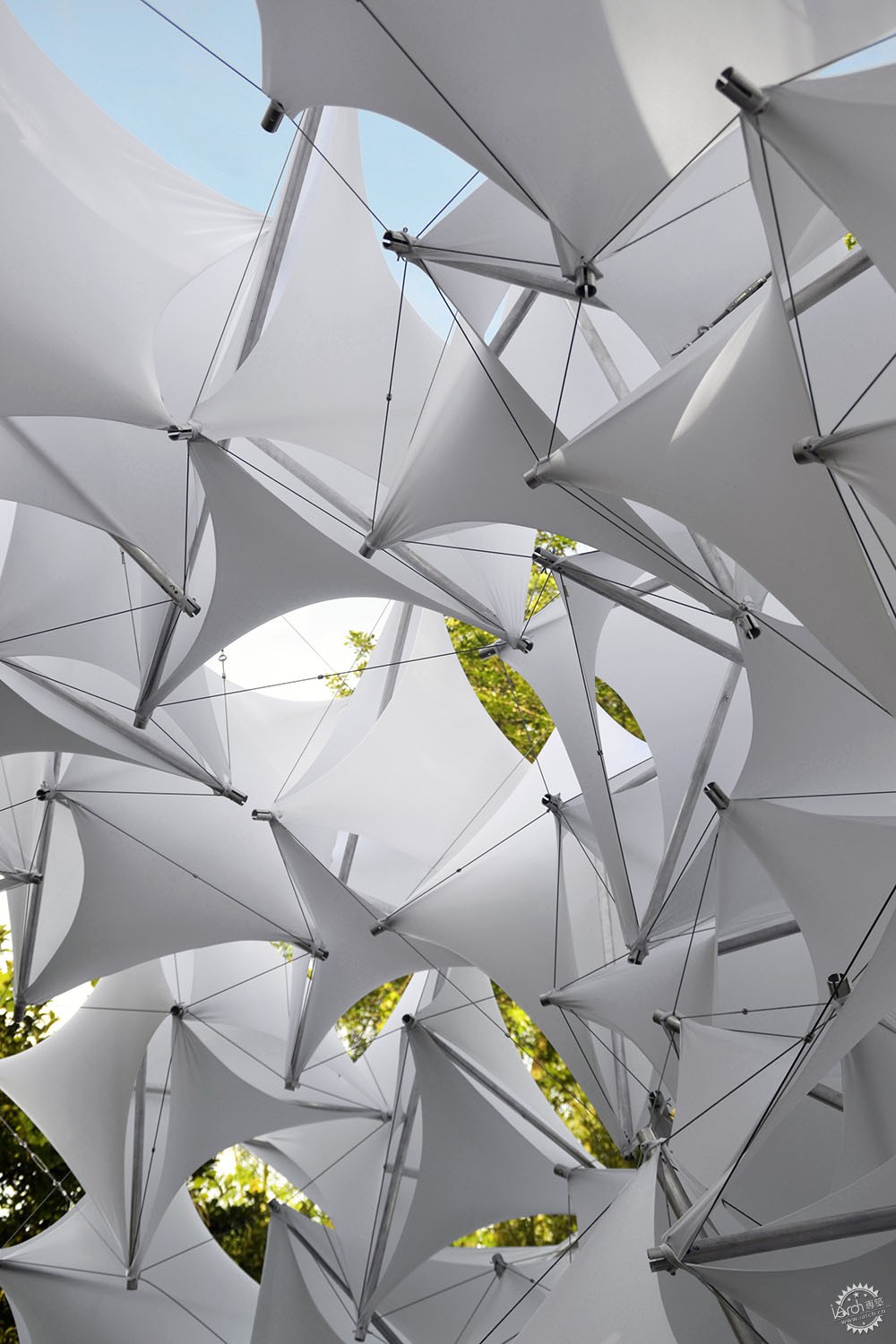
Buckminster Fuller ©POET ARCHITECTURE via Flickr Licence Public Domain Mark 1.0
张拉整体结构:它们是什么?它们怎么用?
Tensegrity Structures: What They Are and What They Can Be
由专筑网李韧,吴静雅编译
通过重重的研究与实验,“张拉整体结构”由巴克敏斯特·富勒(Buckminster Fuller)最初创建,主要用于描述“由绳索、电缆等刚性构件组合而成的结构系统,该系统具有张力与拉力” [1]。换句话说,该结构系统的张拉整体性是其一大特质,整个系统通过具有拉力的绳索和具有刚性的构件组成,在一定应力的作用下,形成一定的阻力与稳定性。该结构的每个构件都是完整不可分割的一部分,就如同人体肌肉与骨骼相互作用一般,二者相辅相成。
Georgia Victor认为:“根据几何特征而构成整个系统的组织,这种空间组织通过地心引力和内在的平衡而形成连续的张力与拉力。”[2]
Through his extensive research, inventions and structural experiments, Buckminster Fuller created the term tensegrity to describe "self-tensioning structures composed of rigid structures and cables, with forces of traction and compression, which form an integrated whole" [1]. In other words, tensegrity is the property demonstrated by a system that employs cables (traction) and rigidity of other elements (usually steel, wood or bamboo) capable of acting under the intrinsic stresses (traction and compression) together and simultaneously, giving greater resistance and formal stability. It creates an interconnected structure that works biologically like muscles and bones, where one element strengthens the other.
For Georgia Victor, "It is used today to explain the organization of the elements that make up living beings according to the characteristics of their geometry. This spatial organization forms a continuous field of tensions and compressions in constant equilibrium, in a game of tensions with the force of gravity. " [2]

Parametric Tensegrity Structure for Local Art Fair. Image © Gernot Riether
总体来说,根据Fuller的说法,这个系统通过对抗力量形成,它“以自然的机构基础,运用最少的元素,形成坚固的结构” [3]。美国当代雕塑家Kenneth Snelson曾经是Buckminster Fuller的学生,Snelson在这种结构系统的发展中就发挥着重要的作用,该系统刚柔并济。
Snelson运用这一结构系统的代表作是Needle Tower,这座雕塑设计建造于1968年,高18米,宽6.18米,长5.42米,这位雕塑家在Fuller张拉整体性分析的理论基础上进行构思。由Fuller于1948年而设计的网格型穹顶已经初具张拉结构的雏形,但是在最初的装配过程中遇到了一些小困难[5]。
In general, the system works by joining opposing forces and, according to Fuller, is the "structural basis of nature; capable of, with a minimum of elements, forming a strong structure" [3]. American contemporary sculptor Kenneth Snelson - a former student of Buckminster Fuller's - played an essential role in the development of the structural system, working with pieces composed of rigid and flexible components.
Snelson's work that best embodies the system is the Needle Tower, a sculpture created in 1968 measuring 18 meters high, 6.18 wide and 5.42 meters long that allowed Fuller to theoretically develop the idea from tensile integrity analysis. The geodesic dome designed by the architect already hinted toward the notion of the tensile structures in 1948, despite the difficulties met in the assembly process of the prototype which stood only for a few minutes [5].

Neddle Tower © Clayton Shonkwiler via Flickr Licence CC BY 2.0
结构体系中的刚性构件主要用于抗压缩力,在排布时,构件与构件之间没有直接接触,而是环绕承受拉力的绳索而布局。而后,这一概念得到了延伸,结合有诸如Fuller网格型穹顶的“不平衡结构,其中运用了拉索与杆件相互分隔的原理” [7]。
Rigid bars act on compression forces and are arranged in an isolated, non-touching manner, complimenting the steel cables that receive tensile forces. The concept was expanded, incorporating "structures that may not be self-balanced, but which contemplate the principle (...), formed by tension cables and compressed bars isolated from each other" [7] like Fuller's geodesics.

Easy K_Kenneth Snelson © Robin Capper via Flickr Licence CC BY-NC 2.0
根据Deifeld和Pauletti的说法,这个结构系统让许多研究者为之着迷,也有说法显示,运用该系统的制作的最大建筑结构是格鲁吉亚亚特兰大的格鲁吉亚穹顶(Georgia Dome)[8]。最近的研究表明, Kuan-Ting Lai所谓的“重构性张拉整体系统”使用了这些原理而形成了完整的结构体系,这种结构体系遵循系统的基本规则。然后基于此原理通过气缸和聚碳酸酯板组合而成,这些构件大大显示了其潜力。
The system has been attracting the attention of researchers, as Deifeld and Pauletti say. According to the authors, the largest architectural structure to use the system is likely the roof of the Georgia Dome [8] in Atlanta, Georgia. Recent research, such as that of Kuan-Ting Lai termed "Reconfigurable Tensegrity Systems," has sought to explore the possibilities of using the principles to construct a structural system that can be reconfigured later from an understanding of the basic rules of the system, with the construction of a prototype of pneumatic cylinders and polycarbonate panels demonstrating this showing the potential.

Parametric Tensegrity Structure for Local Art Fair. Image © Gernot Riether
另一个典型案例是由印第安纳州鲍尔州立大学的学生在教授Gernot Riether和Andrew Wit的指导下所作的研究项目,学生们运用弹性系统设计建造了一座能够遮阴的展览馆,而这种弹性系统由56个光源和运用弹力组织制作的自动遮阴模块组合而成。就其结构而言,这种结构系统来源于诸如Rhino和 Kangaroo等参数化软件的操作,这些软件对于此类结构系统的形成过程不可或缺。
张拉整体结构优势来源于其各个部分的集合,其中每个部分对于这个整体来说都必不可少。许多研究者和建筑师不断地开发此类结构的原型,并且探索此类系统的巨大潜能。虽然这种结构系统在实际建筑项目中较为少见,但其整体系统的运用还是具有一定的发展潜力。
Another example is the research developed by students of Ball State University in Muncie, Indiana under professors Gernot Riether and Andrew Wit, who are working towards formalizing parametric structures from 56 light and auto-shaded modules using elastane tissue to create a pavilion that offers protection from the sun. Structurally it was created from modular variations in measures and rotation from parametric software - Rhino and Kangaroo, essential for the conformation of the formal process.
The properties of the tensegrity structures feature considerable structural advances based on the integrated system of all their parts, in which each part is essential to the function of the larger structure. There are several researchers and architects developing prototypes and seeking a greater understanding of the potential of the system. Although practical applications in architecture and engineering are not yet so common, the system has several possible applications.

Parametric Tensegrity Structure for Local Art Fair. Image © Gernot Riether

Parametric Tensegrity Structure for Local Art Fair. Image © Gernot Riether

Needle Tower_Keneth Snelson © Neil R via Flickr Licence CC BY-NC 2.0

注释
[1] (DA SILVA; FARBIARZ. 2016. p. 2007-2008).
[2] (VICTOR. 2008. P.22).
[3] (FULLER) in: (DA SILVA; FARBIARZ. 2016. p. 2008).
[4] (VICTOR. 2008. P.22).
[5] (DEIFELD; PAULETTI. 2002. p.04).
[6] (DEIFELD; PAULETTI. 2002. p.04).
[7] (DEIFELD; PAULETTI. 2002. p.04).
[8] (DEIFELD; PAULETTI. 2002. p.05).
|
|
